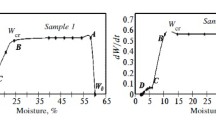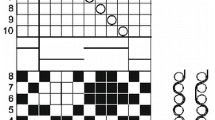A composite textile material is a material consisting of two or more components formed by textile technologies into a unified structure with physicomechanical properties that differ from the properties of the components. Theoretical and experimental investigations were carried out, and a complex mathematical model was developed for the kinetics of impregnation of textile materials with aqueous dispersions and solutions of polymeric binders with various compositions. This made it possible to determine rational regimes for the formation of composite textile materials in relation to their geometric characteristics and also to the physicochemical characteristics of the binder.




Similar content being viewed by others
References
N. N. Yasinskaya, V. Ol’shanskii, A. G. Kogan, Composite Textile Materials: Monograph, VGTU, Vitebsk (2016), 299 pp.
Yu. M. Treshchalin, Composite Materials Based on Nonwoven Fabrics [in Russian] (2015), 220 pp.
S. S. Voyutskii. Physicochemical Principles of Soaking and Impregnation of Fibrous Systems with Aqueous Dispersions of Polymers [in Russian], Khimiya, Moscow (1969), 336 pp.
V. A. Braslavskii, Capillary Processes in Textile Materials [in Russian], Legprombytizdat, Moscow (1987), 112 pp.
Yu. M. Treshchalin, Analysis of Structure and Properties of Nonwoven Materials [in Russian], Izd. BOS (2016), 192 pp.
A. S. Imankulova, Textile Composites [in Russian], MOK, Bishkek (2005), 152 pp.
V. P. Gusev, Principles of Hydraulics: Textbook [in Russian] (2009), 172 pp.
N. N. Yasinskaya, A. N. Bizyuk, K. È. Razumeev, Izv. Vuzov. Tekhnol. Tekst. Prom-sti,. No. 6 (378), 273-277 (2018).
A. N. Bizyuk, S. V. Zhernosek, et al., Izv. Vuzov. Tekhnol. Leg. Prom-sti, 23, No. 1, 16-18 (2014).
Author information
Authors and Affiliations
Corresponding author
Additional information
Translated from Khimicheskie Volokna, No. 1, pp. 27-31, January-February, 2020.
Appendix
Appendix
Rights and permissions
About this article
Cite this article
Yasinskaya, N.N., Murycheva, V.V. & Razumeev, K.E. Impregnation of Woven Fabrics from Chemical Yarns during Formation of Composite Textile Materials. Fibre Chem 52, 28–33 (2020). https://doi.org/10.1007/s10692-020-10145-2
Published:
Issue Date:
DOI: https://doi.org/10.1007/s10692-020-10145-2




